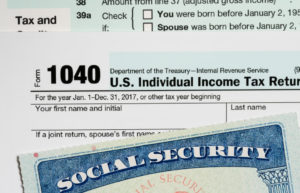There are some tax changes for 2020 that all tax filers should be interested in.
It’s hard to believe the time to start thinking about filing taxes is already almost upon us.
Every year the U.S. tax code sees some kind of change that impacts all taxpayers. Sometimes those changes are big and sometimes they are minute.
For the 2019 tax year — your return is due in April 2020 — there are tax changes ranging from bracket amounts to standard deductions to health savings account contributions.
And it’s important to know what the changes are and how they may impact you and your family.
Here’s a look at five tax changes for 2020 (tax year 2019) that impact you:
1. Tax Changes for 2020: Standard Deductions
 Perhaps the biggest of the five tax changes for 2020 is the standard deduction you can take when filing.
Perhaps the biggest of the five tax changes for 2020 is the standard deduction you can take when filing.
Just about everyone wins here because the standard deduction for tax year 2019 went up in every applicable category.
Here are the changes, according to the IRS:
- Married, filing jointly — $24,400 (up $400 from tax year 2018)
- Single or married filing separately — $12,200 (up $200 from tax year 2018)
- Heads of households — $18,350 (up $350 from tax year 2018)
As a refresher, the standard deduction is the amount of income subject to federal taxes. For example, a married couple filing joint tax returns would not have to pay taxes on the first $24,400 of their taxable income.
2. Tax Changes for 2020: Tax Brackets
Since 2018, there have been seven different tax rates for individual tax filers. The 2020 tax brackets are the same as last year. Those rates are: 10%, 12%, 22%, 24%, 32%, 35% and 37%.
However, one of the five tax changes for 2020 is a slight rise in the income amounts due to inflation.
Here are those tax brackets for people who are filing as single, according to IRS Rev. Proc. 2018-57:
- 37% — Income of more than $510,300.
- 35% — Income more than $204,100 but not more than $510,300
- 32% — Income more than $160,725 but not more than $204,100
- 24% — Income more than $84,200 but not more than $160,725
- 22% — Income more than $39,475 but not more than $84,200
- 12% — Income more than $9,700 but not more than $39,475
- 10% — Income of $9,700 or less.
Here are the brackets for those married individuals filing joint returns:
- 37% — Income more than $612,350
- 35% — Income more than $408,200 but not more than $612,350
- 32% — Income more than $321,450 but not more than $408,200
- 24% — Income more than $168,400 but not more than $321,450
- 22% — Income more than $78,950 but not more than $168,400
- 12% — Income more than $19,400 but not more than $78,950
- 10% — Income of $19,400 or less
3. Tax Changes for 2020: Health Savings Accounts
 A lot of companies today offer employees the option of a health savings account or HSA.
A lot of companies today offer employees the option of a health savings account or HSA.
An HSA is basically a savings account that allows you to save pretax money to use for medical expenses. Because the money is pretax, there is the possibility you can lower your overall health care expenses by using one, according to HealthCare.gov.
One of the tax changes for 2020 is a raise in the contribution limits and out-of-pocket expenses for people who are eligible for an HSA.
Here are the changes in deductibles:
- Self-only coverage — Not less than $2,350 and not more than $3,500 (up $50 from tax year 2018)
- Family coverage — Not less than $4,650 and not more than $7,000 (up $150 from tax year 2018)
Here are the out-of-pocket changes:
- Self-only coverage — $4,650 (up $100 from tax year 2018)
- Family coverage — $8,550 (up $150 from tax year 2018)
4. Tax Changes for 2020: Retirement Account Contributions
According to a Stanford Center On Longevity study, around 90% of Americans who have access to a 401(k) retirement savings plan use it.
In addition to saving for retirement, a benefit of a 401(k) is the ability to save money out of your paycheck automatically. Also, if you are fortunate enough, your employer may also match your contribution up to a certain percentage.
You can also deduct contributions from your tax return.
Another of the tax changes for 2020 includes a raise in contribution limits to 401(k) plans and individual retirement accounts:
- 401(k) base contribution — $19,000 (up $500 from tax year 2018)
- 401(k) catch-up contribution (taxpayers over 50) — $25,000 (unchanged from last year)
- IRA base contribution — $6,000 (up $500 from tax year 2018)
- IRA catch-up contribution (taxpayers over 50) — $7,000 (unchanged from last year)
5. Tax Changes for 2020: Health Insurance Penalty
Under the Affordable Care Act, there are people who are required to have health insurance.
If you are one of those people and you weren’t covered, you were subject to a penalty — due when you paid your taxes. This was known as the individual mandate penalty.
However, one of the tax changes for 2020 came thanks to the Tax Cuts and Jobs Act, which zeroed out that individual mandate penalty. That penalty was $695 per adult and $347.50 per child, up to $2,085 per family.
Essentially, if you didn’t have health insurance coverage in tax year 2019, you won’t be penalized when you file your taxes in 2020.
Whether it is a standard deduction or the health insurance penalty, these are the biggest tax changes for 2020.
While there are always changes to tax law that impact both businesses and individuals, it’s important to know which are the tax changes for 2020 that impact you the most.





